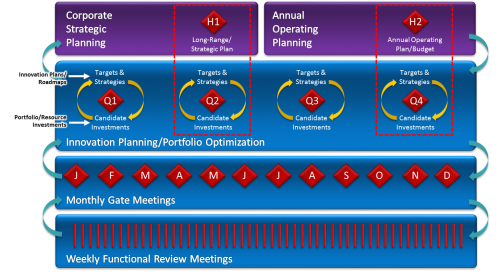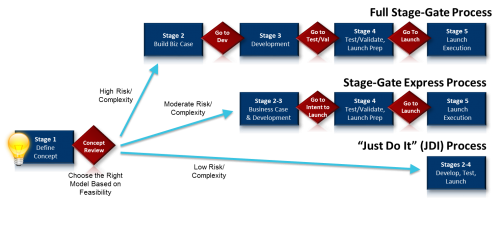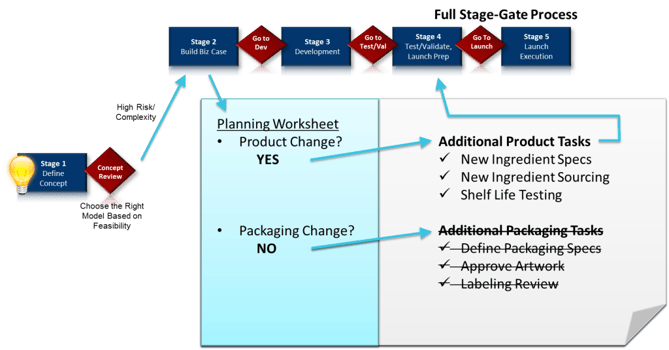This is the second in a three-part commentary addressing how consumer firms can leverage a new approach to “Agile” innovation to reduce their cycle time from consumer insight to market launch, and create a steadier stream of higher-value new products. In Part One, I describe how the current state of consumer goods innovation compares to Agile principles. In this post and in Part Three, drawn from my webinar on the same topic, I'll describe how the Agile principles from the world of software development can be adapted to the unique context of consumer firms, in combination with emerging practices from the world of product portfolio management (PPM).
Here's a fun fact. You likely know that elephants enjoy water, like those playful elephants from the Jungle Cruise at Disney World. But did you know that elephants can swim for miles? Experts have suggested that elephants may have once swum from Southern India all the way to Sri Lanka, where they eventually settled. Apparently, their large bodies provide just enough floatation while their trunks act as a type of snorkel.
This may seem an odd way to introduce an article on innovation. But I do so because in some ways, the swimming elephant is a perfect metaphor for what is being demanded of business leaders in the consumer firms I talk to on a regular basis. Executives in companies like PepsiCo, Electrolux, and P&G are trying to take these huge animals—in the form of a very large enterprise—and push them to perform a specific type of activity—agile innovation—that we usually associate with a leaner, more athletic body type. And yet, just as elephants can swim, it is possible for large- and medium-sized companies to innovate in a much more agile manner than they do today.
In Part 1 of this article series, I introduced the basic principles of Agile product development and argued that they offer guideposts for innovation improvement to which consumer firms should pay attention—even though these principles differ sharply from the reality of their current experience. Today, I'll dig deeper into what that means, and share how we are beginning to see large- and medium-sized enterprises implement these principles by tying Agile to a new set of capabilities that come from the arena of product portfolio management (PPM). In this article, I'll highlight two of those principles. In an upcoming third and final article in this series, I'll describe two more.
1. Organize work in short, iterative cycles
A central principle of Agile is that work should be organized in shorter, iterative cycles, known as “sprints.” Now, for most food or CPG manufacturers, the classic software development approach of a very short iteration—typically a 2-week sprint—doesn't directly apply to their world. But let's think about what is possible to help these companies thinkmore iteratively than they do today.
What we see many companies doing to increase their focus on iteration is creating shorter windows between major investment decision points. Specifically, this means a cycle of portfolio prioritization at regular intervals—90-day “sprints” are most common—to do just that. To be clear, these are not just portfolio status reviews where leaders are simply “checking in”; these are hard-nosed decision cycles in which every project is reconsidered and potentially reprioritized. See Figure 1 for an example cadence.

Figure 1: Example of a 90-Day Agile Cadence
These meetings are typically centered at the business unit or brand level. The agenda is to look hard at the portfolio—literally, the combined list of candidate and active projects—and ask two questions: First, how well is the current portfolio meeting the targets that we set out to accomplish? And second, is our current portfolio better or worse compared to the last time we looked?

Figure 2: Example Portfolio Analysis: Current Portfolio vs. Last Quarter
To really get at the essence of iteration requires this comparison of where we are today compared to the last time we looked at our portfolio. In Figure 2 above, you can really tell what has changed in the last 90 days, and it's not pretty:
- The total number of projects increased from 44 to 47
- Our revenue went up slightly (1% increase)
- Our cost has skyrocketed (10% increase)
- Our margin went down (4 decrease)
In Part 3 of this article series, I'll address how portfolio teams can overcome these challenges by optimizing their portfolios. But for now, we'll leave this topic by noting that this type of side-by-side comparative analysis is the key to assessing the health of our portfolio and whether or not we are truly making progress as a company, or moving in the wrong direction.
2. The whole team defines the work
The second Agile principle we'll discuss here is the idea that Agile teams have control over their own work, “defining the work goals before each cycle starts” and then “deciding how to do the work within the iteration.” To address what we see consumer firms doing in this regard, we'll step down for a moment from the portfolio level to the team level, and illustrate a new method we see teams using to gain increased control over their work as they begin a project. For most consumer product development teams nowadays, they know the way they are supposed to organize their work is via a Stage-Gate® process. However for many of those teams, too often there is a “one size fits all” process that forces all projects down the same path, regardless of project type or complexity. Increasingly however, companies are modeling the process in a more flexible manner, in which there are a small number of process models that are matched to the risk and complexity of the project. One of the first things that happens in the project is that the team assesses what it will take to manage the risk, and then the team recommends an appropriate process model. This model in itself makes teams more agile as they are only required to work toward the number of gate meetings that truly enable them to manage the actual level of risk.

Figure 3: Map Your Stage-Gate Process to the Right Level of Complexity
More recently we are seeing teams define new ways to “tune” those projects even further, and minimize their work on unnecessary tasks. This is managed via early-stage tools that can dynamically build out the appropriate process model with finer distinctions. For example, a tool called a planning worksheet is completed that asks the project team to assess its work based on a few key parameters: for example, “does this project require a product change (yes/no)?” If yes, then certain tasks are added to the project. If it also requires a packaging change, then certain other tasks are added to the project. Most importantly, if tasks are not required they aren't even presented to the team as an option.
By answering a small number of questions, it's possible to define a recommended project timeline with all key milestones laid out in front of the team. Most importantly, the tasks in the project plan are automatically adjusted to only include those that matter. The entire detailed project schedule is instantly laid out, and is appropriate for the level of risk and the real requirements of the project.

Figure 4: Dynamic, “Smart” Process Models
The swimming elephant, to be continued…
We've only tackled two principles so far, but hopefully the illustrations above begin to paint a picture of how some consumer firms are applying Agile to increase their pace of innovation. Leveraging these principles, market leaders such as PepsiCo, P&G, Electrolux and others are becoming like that swimming elephant I mentioned in the introduction—they may not always be as elegant or athletic as a smaller, leaner consumer firm, but they are still moving quickly while leveraging their massive advantages of scale, which is keeping them afloat and swimming ahead even in these turbulent waters.
We'll continue this story in Part 3 of this series, due out next month, in which we'll tackle two more of these principles: (a) how companies and teams can better control their time, thereby minimizing interruptions, and (b) how companies and teams can measure their own performance, driving new learning and creating real continuous improvement. If you want to take a sneak peak at those two principles, and also hear some elaboration on the points above, please watch the replay of my recent webinar in which I tackled these same themes.




